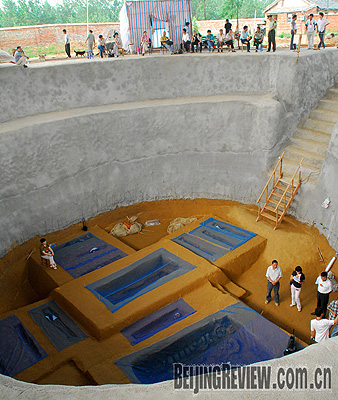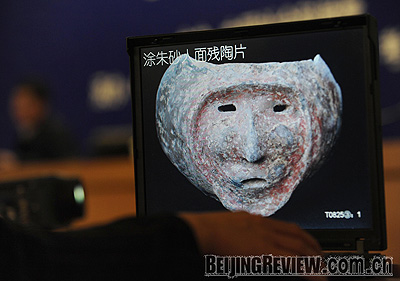 |
|
The round-shaped emperor's grave of the Spring and Autumn Period in Anhui Province [CFP]
|
Xu Pingfang, one of the leading archaeologists in China who works at the Institute of Archaeology under the Chinese Academy of Social Sciences (CASS), told Xinhua News Agency how important the discoveries were.
All the projects that were included in the top 10 are of great archaeological value and have significance in the development of the field," Xu said.
He said the new discoveries refer to those that have value in terms of academic study, in the development of archaeology and in the outcome of the study, adding that it does not simply mean a discovery that people have never seen before.
The Shuangdun Tombs of the Spring and Autumn Period (770-476 B.C.) discovered in Bengbu, central China's Anhui Province was a great discovery, and the archaeological outcome surprised archaeologists and anthropologists. From these 2,600-year-old tombs experts found aspects of new civilization and architecture ruins that have never been seen before. The form, structure and relics are very complicated. The earth that was used to build the mausoleum was composed of soils of five different colors, and those soils were from different regions. The round-shaped grave pit has also never been seen before.
Xie Kelin, Director of the Bureau of Cultural Heritage of Bengbu, said at the media briefing that the tombs are the first round-shaped graves found in China and that they show many unknown aspects of Chinese civilization in terms of new culture and new interment methods. Besides this, they also helped archaeologists learn about a forgotten kingdom of Zhongli, in ancient China, Xie added.
 |
|
A piece of a pottery found in the Yangguanzhai ruins in Shaanxi Province
|
Another graveyard of the Spring and Autumn Period in central China's Henan Province was also one of the top 10 selections of 2008. Ma Juncai, a researcher at the Institute of Archaeology and Cultural Relic Research of Henan Province, said at the media briefing that the mausoleum was confirmed as the tomb of an emperor from the third century B.C. The artifacts unearthed and the structure of the mausoleum filled in many blanks about this period, said Ma.
Ma and his team began the excavation in 2006, and the excavation area reached 12,000 square meters. Ma told reporters that to the surprise of archaeologists, the cultural relic protection work carried out to cooperate with an important water project of China, called South-to-North Water Diversion, brought about a big archaeological outcome.
The water diversion project is an important construction that the Chinese Government carried out to relieve the water shortage of the northern area of the country. According to the project, part of the water of the Yangtze River in the south will be transferred to the northwestern and northern areas of the country. The project will be carried out along three routes. The middle line was completed in 2007 and the eastern line is planned to be finished in 2010. According to the primary statistics, the project might unearth more than 700 historical sites. To protect and rescue the cultural relics related with these sites, Chinese archaeologists have been busy in discovering and conserving these relics.